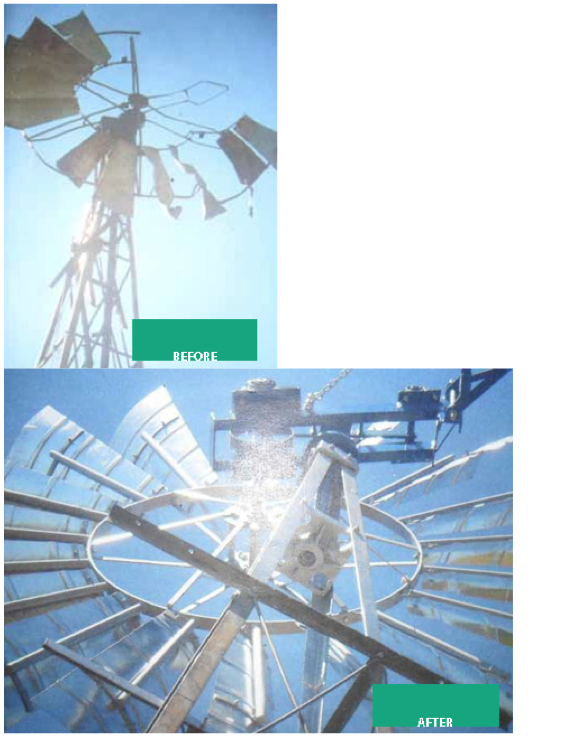Farming programme makes tripe a cash cow
Farming programme makes tripe a cash cow sadminGoing from selling tripe for survival to landing a R1 million contract was not an easy road for farm manager Maleshoane Mabel Mochakane. The Mochakane family started farming without experience, financial backing, proper implements, skills or technical ability. However, with determination, perseverance and the will to learn, and support from the Recapitalisation and Development Programme (RADP), they achieved success.
 Maleshoane first displayed business acumen by selling tripe in Virginia in the Free State, before taking over the derelict, overgrown farm with a broken windmill bought by government for restitution.
Maleshoane first displayed business acumen by selling tripe in Virginia in the Free State, before taking over the derelict, overgrown farm with a broken windmill bought by government for restitution.
Today, the farm has landed a R1 million contract to supply tripe to Harmony Gold mines in Virginia, Odendaalsrus, Welkom and Theunissen.
The 1 400 hectare farmland comprises four farms; Avignon, Brakpoort, Rothenberg and Hughenden, in the Wesselsbron area in the Free State. The Department of Rural Development and Land Reform (DRDLR) bought the farm in 2010 to compensate 39 households, who then formed Mochakane CPA Trading.
Skills and resources
Through the RADP, the department helped the Mochakanes gain skills and resources to run the farm. “They bought us three tractors, cultivators, rippers, off-sets, sprayers and pivots,” Maleshoane says.
Graeme Leach, who is a strategic partner from Bloemfontein Abattoir responsible for mentoring the Mochakane clan, says initially there were only four people who depended on food from the farm, but since the RADP, the farm supports 24 families.
The RADP provides for established farmers and co-operatives to mentor emerging farmers. Commodity organisations, such as Grain SA and SAPPI, also provide expertise depending on the specific needs of the emerging farmer, as the sustainability of their businesses depends on agricultural produce.
Leach says the farm owned by the Mochakanes has undergone phenomenal growth. “The number of cows on the farm has increased from 25 when it started to 102. The sheep count stands at 108 and we’ve got 70 cows and 68 lambs that can be sold to the market.” The farm’s biggest clients are supermarkets such as Pick n Pay, Shoprite and Spar, and Harmony Gold mines.
Bright future
The future looks bright for the farm and Maleshoane hopes it will continue to grow. “We are supplying 7 500 tonnes of tripe to the mines and we’ve got a year’s contract with an option to renew it at the end of the year,” she says.
Leach commends Maleshoane for displaying interest in running the farm and expresses confidence that her dedication will make the farm a success. “Bloemfontein Abattoir has enjoyed working with her as she is committed to the farm. She has been actively involved in developing and managing the business plan to restore the farm to productivity and under- stands how RADP has improved their livelihoods. Maleshoane and her family have been enthusiastic and committed to developing the skills required for farming through classroom training as well as practical on-the-job training.”
Recapitalisation programme
The RADP is managed by the DRDLR to in- crease agricultural production, guarantee food security, promote job creation and graduate small-scale farmers to commercial farmers.
Government introduced the programme after a study revealed that over 3 000 farms, which received subsidies from the land redistribution projects between 2005 and 2008, were in distress. Part of the programme was to establish a working relationship between established farmers and emerging farmers.
“We realised that projects initiated through land reform programmes are failing and some are about to fail. Because of this the department decided to involve the experience of the commercial farmers to ensure that these projects are recapitalised,” the department’s Mtobeli Mxotwa says.
Management teams
But the journey of transforming farms and the farming sector has not been without challenges. Part of the reason for meeting with farmers and strategic partners, explains Mxotwa, is to evaluate the programme since its launch.
“Key components of the methodology for each farm include preliminary activities to obtain available information and meeting key role-players and establishing management teams where they don’t exist.”
He adds that plans were underway to investigate and write a credible development plan including redesigning the whole project if this is necessary.
Facts about the recap programme:
- The Department of Rural Development and Land Reform (DRDLR) put a selected number of collapsed farms under the Recapitalisation and Development Programme in a bid to revive them.
- The department has set a target of 403 projects within its various programmes and sub-programmes to be recapitalised in 2012.
- The strategic partners come with their own resources and guarantee uptake or buying of products from the farmers.
- The aim of the RADP is to increase the number of farms that are producing food for households and to enhance food security and other needs.
- To increase the output of farms that is geared towards commercial production in order to provide increased food security for the nation.
- To improve income for farmers and employees.
- To increase the capacity of emerging farmers, job creation, productivity and contribute towards rural transformation.
- To contribute towards the gross domestic product and by increasing exports, to contribute to the balance of payments positively.